It happens to everyone – your house goes cold, so you check your thermostat, only to find that your furnace is not turning on.
What do you do next?
I’ve spent a lot of time out in the field, and here’s the truth: There are all sorts of things that causes a furnace to not turn on!
In this article, I’ve compiled a list of the most common reasons why a furnace doesn’t turn on. My list starts with the most common causes that I’ve found, and as it goes on, it gets into the less common and more niche reasons.
Here’s the list:
Thermostat Issues
The most common reason for a furnace to not turn on is due to thermostat issues.
Of all the thermostat issues, dead thermostat batteries is one that happens quite often. Fortunately, most people figure out that their thermostat’s batteries are dead right away and change the batteries themselves.
Another issue that happens with thermostats is bad thermostat wiring or loose thermostat wiring. If you have a wired thermostat, the wiring behind your furnace’s thermostat connects to your furnace’s control board.
Bad Thermostat wiring
Bad thermostat wiring occurs when the wiring gets scuffed, nicked, or pinched. The wiring ends up touching another wire or touching a piece of metal and shorting out.
Another issue that can occur is the thermostat wiring can get cut somewhere and that will prevent your furnace from turning on.
Loose Thermostat Wiring
The wiring that connects to the thermostat and control board’s terminals can sometimes loosen up and lose its connection, preventing your furnace from turning on.
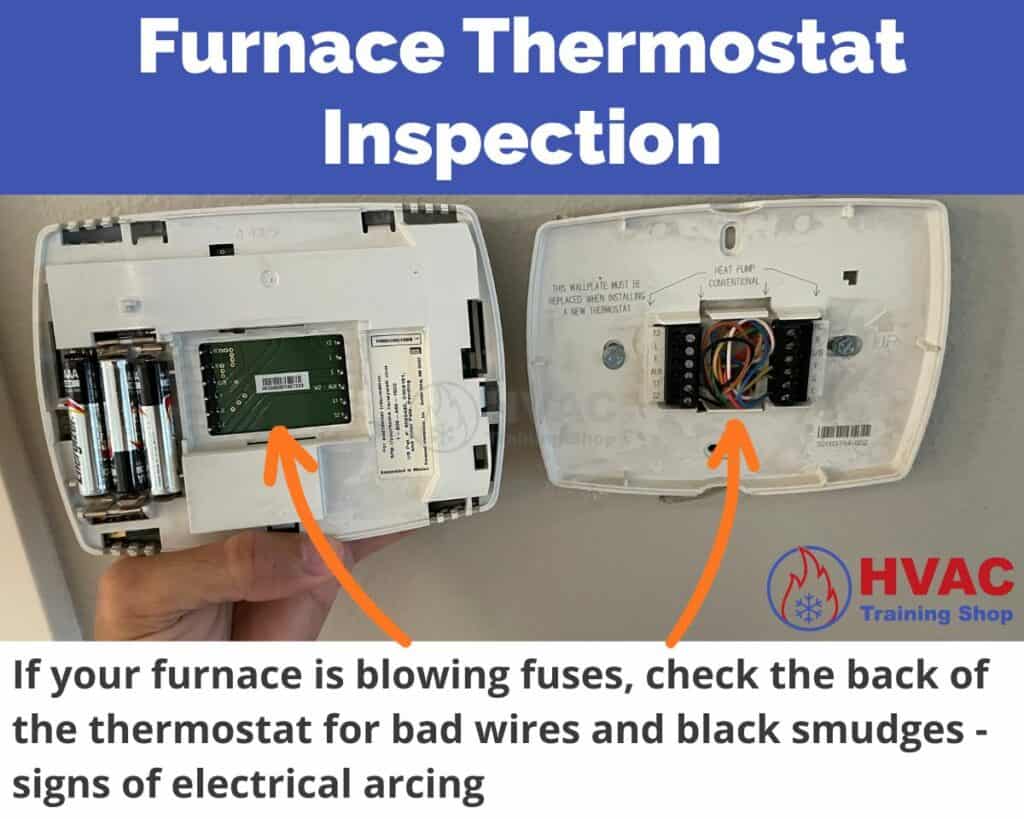
Dirty Flame Sensor
After thermostat issues, a dirty flame sensor is the thing that I see most often that causes a furnace to not turn on.
The flame sensor is a device in your furnace that ensures that its burners light up when the furnace turns on.
If the flame sensor doesn’t detect a flame when your furnace turns on, it shuts down your furnace to prevent unburned gas from leaking out of the furnace.
However, if your flame sensor is dirty, it will shut down your furnace – even when the burners light up successfully.

Fortunately, cleaning a dirty flame sensor is a simple task that most homeowners can do themselves.
I wrote an article about furnace flame sensors (and how to clean them) here:
Dirty Air Filter
Look, I know that dirty air filters are practically the cause of every HVAC issue possible, but they really are that bad.
Especially when someone forgets to change them.
I’ve seen clogged up air filters completely collapse and get wrapped around blower motors, causing the motor to fail.
While that’s a drastic example, dirty air filters are “quiet killers” of furnaces everywhere.
Clogged air filters reduce the airflow flowing through your furnace, causing its pressures and heat transfer properties to get all out of whack.
Over time, a clogged air filter will slowly kill a blower motor, or worse – cause a heat exchanger to crack (which in most cases means you need a whole new furnace).
That’s why anytime I go out on a trouble call, one of the first things that I do is check the air filter (and usually end up changing it).
I recommend changing your air filter every 1-2 months – and even more often if you have pets or live in a dusty area.
Bad Inducer Motor
The inducer is the “other fan” in your furnace that blows air around. But instead of blowing air through your home like the blower, the inducer sucks air through the burners and heat exchanger to keep the flame burning and eject those harmful combustion gases outside of your home.
So you can see how the inducer motor is a critical component – it literally prevents furnace exhaust from infiltrating the air inside your home.
That’s why there is at least one (and sometimes two) pressure switches hooked up to the inducer to ensure that its producing airflow. If the pressure switch doesn’t detect airflow when the inducer turns on, then your furnace shuts down.
When a furnace goes through its heating sequence, the inducer motor is the FIRST thing that turns on. So if your furnace’s inducer isn’t working, then nothing else will happen.
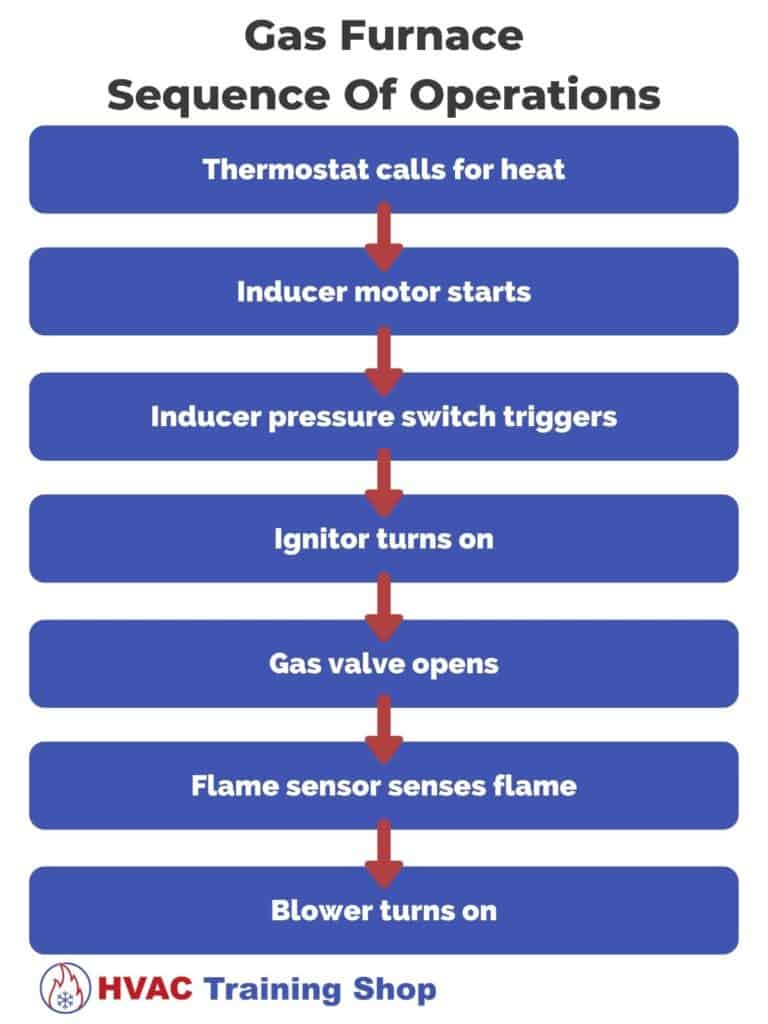
I’ve written a whole article on furnace inducer troubleshooting, which you can check out here:
Bad Blower Motor
I’ve already briefly touched upon bad blower motors earlier in this article. While blower motors do sometimes go bad due to catastrophic reasons (like caved-in air filters), blower motors usually go bad for less anti-climactic reasons.
The most common reason for a blower motor to go bad isn’t actually the blower motor itself. Rather, its the blower motor’s capacitor.
The blower motor capacitor is a device that’s required for most blower motors to run.
If your blower motor is a permanent split capacitor (PSC) motor (most are), then it will have a separate component wired to it.
This component is the run capacitor, and without going into too much detail, it basically helps the blower motor turn on and start spinning.

Even though the capactior is the usual culprit behind a non-functioning blower motor, the blower motor itself does go bad from time to time. Especially if its capacitor started to go bad first.
I’ve written a whole article about what you should do if your furnace’s blower isn’t working, check it out here:
Blown Control Board Fuse
Let me start by saying this:
Control board issues are always a pain in the butt.
Why is that?
It’s because you’re never sure if its the control board itself, or if its some other component in the furnace that’s causing the issue.
Of all control board issues, a blown control board fuse is the most common one. A blown control board fuse will stop a furnace from turning on, and make it look like your furnace is completely dead since its indicator light will go out too.
Fortunately, there is a method I use to track down why a furnace control board is blowing its fuse, which you can read all about in my article here:
If your furnace’s control board isn’t blowing its fuse, you could potentially have a bigger problem on your hands.
Bad furnace control boards are tricky to diagnose, and while I recommend hiring a professional to take a look at it, there are some things that you can check out yourself, which I cover in my article below:
Gas Valve Issues
Furnace gas valve issues are always tricky because of the nature of gas. It’s flammable.
That’s why I always recommend hiring a professional once you’ve confirmed that you have an issue with your furnace’s gas valve.
But how do you figure out if your gas valve is bad in the first place?
Sometimes its just something simple – like a closed gas shutoff valve or gas valve switch that’s turned off.
However, one of the most common issues with furnace gas valves is that they can become stuck.
A stuck gas valve is usually due to a bad solenoid or built-up gunk in the valve that prevents it from opening.
If all of that sounds foreign to you, do yourself a favor and hire a professional.
However, if you don’t mind getting your hands a little dirty, read my article below about what you should do if you think your furnace gas valve is stuck:
Bad Ignitor
The ignitor is the part of your furnace that gets the flame going. Think of it like the spark that starts the fire (because that’s literally what it is… well, in some furnaces anyway).
Most ignitors nowadays are hot surface ignitors. These are easy to spot since they glow orange when they turn on, just like the heating coil in an electric stove.
The problem with ignitors is that they don’t last forever. An ignitor usually gets about 5 years of use then goes bad, at which point you’ll need to replace it.
So how do you know if your ignitor has gone bad?
If you have a hot surface ignitor, it’s simple. After the inducer starts up and the pressure switch triggers, the ignitor is the next thing to turn on.
A hot surface ignitor produces an orange glow, so turn off the light and if you see the inside of your furnace glowing orange when it starts up, then you know your hot surface ignitor is working.
So what happens when you need to swap your hot surface ignitor out for a new one?
Hot surface ignitors in particular can be very delicate, especially if you handle them incorrectly. They are fragile and prone to cracking if it gets dropped or are as much as bumped into.
If you touch the heating element portion of a hot surface ignitor, the oils from your hand will deteriorate the ignitor and cause it to crack prematurely.
For more information about checking and replacing your hot surface ignitor, check out my article here:
Tripped Safety Device
Every furnace has a few different safety devices built into them to ensure that things run smoothly:
- The high limit switch detects if your furnace gets too hot, so it doesn’t cause any other problems like a cracked heat exchanger.
- The flame rollout switch detects whether the flames “roll out” of the furnace’s burners. That way your furnace doesn’t catch on fire.
- The pressure switch detects whether the inducer motor starts up and provides a sufficient draft to expel harmful combustion gases from your home.
If one of your furnace’s safety devices is tripping, then its not the safety device that’s the problem.
Safety devices only trip when something else in the furnace goes wrong. The safety device is there to keep you safe.
A high limit switch will shut off the gas to your furnace’s burners when it trips. The furnace’s control board usually has a timer built into it that will alow the burners to turn back on after the furnace has had some time to “cool down”.
The flame rollout switch will also shut off the gas to your furnace’s burners when it trips. However, unlike high limit switches, flame rollout switches don’t reset automatically.
Most flame rollout switches have a manual reset button on the back of them, so you need to actually go into your furnace to reset the rollout switch before the furnace’s burners will turn back on.
The pressure switch is a different device altogether. Instead of triggering when something goes wrong, the pressure switch triggers when something goes right – if that makes sense.
When the inducer motor starts up and produces a sufficient draft, the pressure switch triggers to let the furnace know that the inducer is functioning properly and there is enough draft to burn gas and expel the combustion byproducts.
If any of these safety devices trip up, then your furnace’s control board will produce an error code that lets you know what went wrong. The error codes usually come in the form of a blinking light, or on newer furnaces there might be a small LED display that shows an actual number.
Tripped Circuit Breaker
Tripped circuit breakers can be tricky because there are all sorts of things that cause them.
And get this – sometimes its not even the furnace that’s the issue! I’ve been on a few calls where there were electrical wiring issues, and one call in particular where the circuit breaker itself was bad (that was a long day).
If a furnace is tripping its circuit breaker, the first thing that I usually check is the blower motor capacitor. A bad blower motor capacitor will cause the blower motor to overamp when it starts up and trip the circuit breaker.
Besides the blower capacitor, it’s always wise to have a look in the furnace for bare wires shorting out, since that can easily cause a breaker to trip.
If your furnace’s circuit breaker keeps tripping, read my article below to figure out why.
Door Switch Open
Did you know that your furnace has a door switch?
Nope, it’s not like the one that’s in your home’s security system. Rather, its a door switch that ensures the cover panel is attached to your furnace before it’s allowed to run.
It’s important for the cover panel to be on your furnace for two reasons:
- If the cover isn’t on your furnace when your furnace runs, air will get sucked right into the furnace – bypassing the air filter. The interior of your furnace will get extremely dirty and clogged up with dust!
- The cover panel also prevents objects (and people) from inadvertently getting inside the furnace.
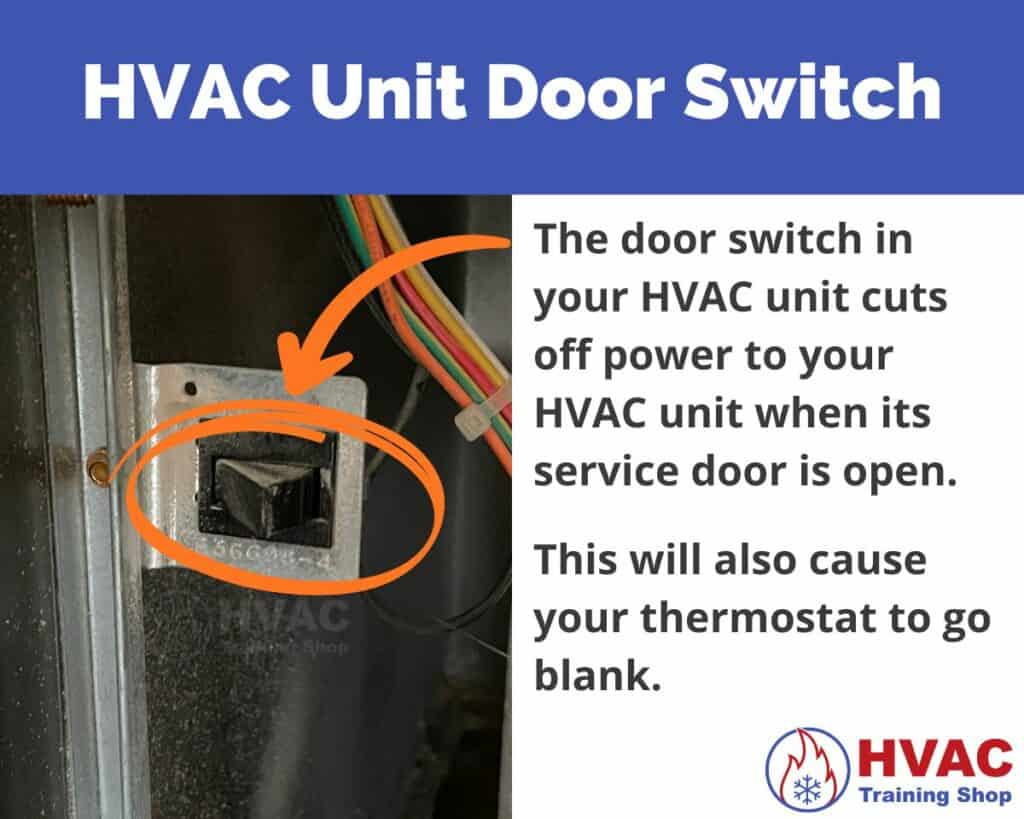
Some people put a piece of tape over their door switch to effectively “bypass” it. And while I don’t recommend doing that, it can be a useful technique if you need to keep the panel off the furnace while you’re watching it run (when you’re working on it). Just remember to remove the tape and put the panel back on afterwards.
Anyway, if the door switch is open, then it will cut off power from your furnace and prevent it from turning on. So if your furnace’s panel is open and you’re wondering why it won’t turn on, the door switch is the reason!
Bad Transformer
Ok, so the transformer is a little component in your furnace that is responsible for converting the line-voltage electricity in your home into the low-voltage electricity that your furnace’s control board uses.
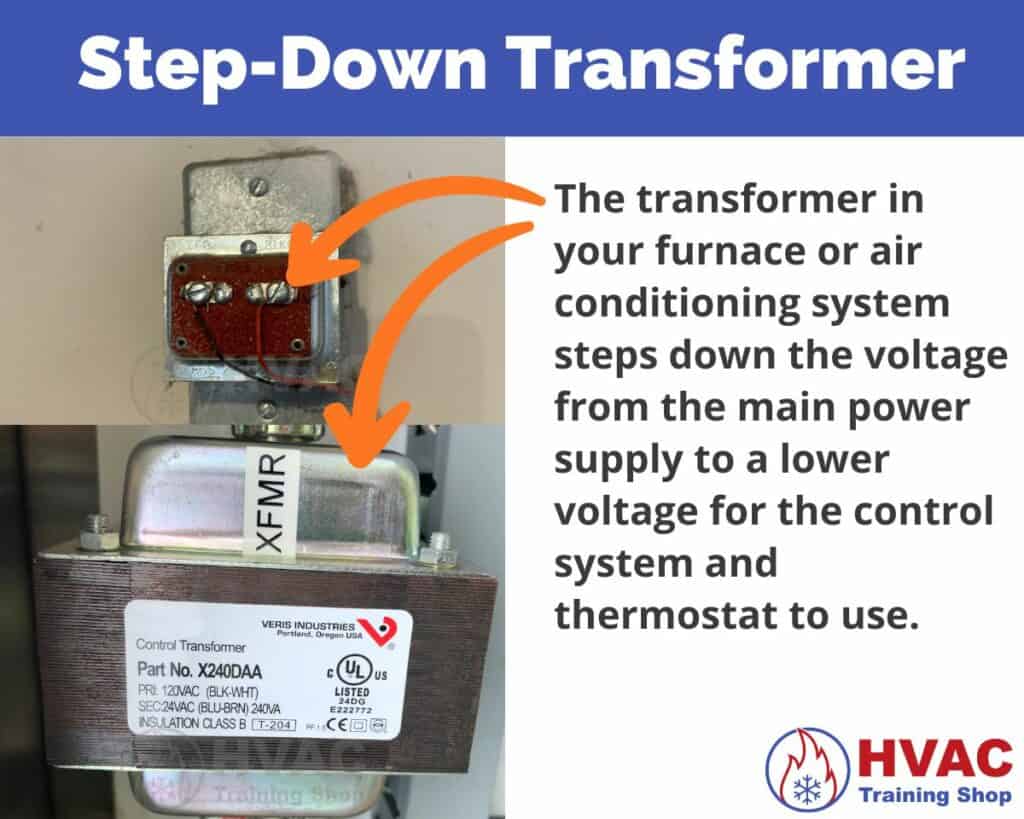
The most common symptom of a bad transformer is a blank thermostat – but only if you have a wired thermostat.
If your thermostat is battery-powered, then the thermostat will obviously stay on (but your furnace won’t).
It’s also worth mentioning that some furnaces don’t have a separate transformer.
Instead, the transformers in some furnaces are built into their control boards. So in the unfortunate event that the transformer in your control board goes out, you’ll need to replace the entire control board.
So how do you know if your transformer has gone bad, anyway?
The test is pretty straightforward. Use a multimeter to test whether you have line voltage (120 Volts AC) going into the transformer and low voltage (24 Volts AC) coming out of the transformer.
If you have line voltage going into the transformer, but no low voltage coming out, then the transformer has gone bad.
Condensate Drain Clogged
A clogged condensate drain line is actually one of the more common causes of a high-efficiency furnace that doesn’t turn on.
But most people don’t have high-efficiency furnaces, so I saved this one for last.
High efficiency condensing furnaces produce water as a byproduct of their combustion. Just like an AC, that water has to go somewhere, so a condensate line (usually made out of PVC) is used to direct the water into a drain or outside.
But sometimes that condensate drain line gets clogged up, and that will keep your furnace from turning on.
Why does a clogged condensate drain prevent your furnace from turning on?
Well, if your furnace kept running with a clogged condensate drain line, all that water has to go somewhere, right? And that somewhere is usually your floor.
So the condensate drain system in your furnace has a device called a float switch that’s used to detect whether there are elevated water levels in the furnace that are indicative of a clogged drain line.
When the drain line gets clogged up, water levels rise in the furnace, and the float switch trips and shuts down the furnace to prevent a flood in your home.
Fortunately, I’ve written an entire article about what you should do if your furnace’s drain gets clogged up, and you can read it here:
So What’s Next?
If you’ve gone through my entire list and STILL can’t figure out the reason that your furnace isn’t turning on, feel free to drop a comment below, and I’ll try my best to help.

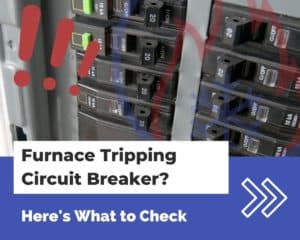


Hi Trey!
My husband and I cannot figure out our mysterious furnace problem.
Our furnace will run fine with the panel cover off but the minute we put it on, the furnace turns off and won’t run. We get “pressure switch stuck open” error code. We tested the pressure switch which seems to test fine but when we bypass the pressure switch, the furnace runs with the door on. We Tested the voltage to the inducer motor which tested fine and we took it off to check for debri. We have made sure the exhaust pipe is clear and pitched right… any suggestions?
Hi Sheila,
Are all of the connections to/from the inducer secure- such as the intake/discharge of the inducer, and its pressure hoses. Since the furnace runs fine with the door off, there is some sort of pressure issue, i’m wondering if there is a disconnect in a hose somewhere.
-Trey
Hi Trey!
We have two rooftop units 1. Lenox 4 ton (2yrs old) 2. Trane 4 ton (27yrs old). Both have same intermittent problem…furnace burners not turning on. note: problem does not occur on both units at same time. WHEN BOTH UNITS WORK…When I turn on the thermostat I can hear the inducer motor on and then hear the burner turn on and after a few moments the main blower motor turns on blowing heated air into the house. WHEN A UNIT DOESN’T WORK…Trane-When I turn on the thermostat immediately the main blower turns on blowing unheated air into the house. After about 5 minutes unit shuts off. Lenox-when I turn on thermostat I hear inducer motor turn on and a few moments later the main blower motor turns on blowing unheated air into the house. After about 5 minutes unit shuts off. Note: each time a tech comes out the units work perfectly. Any advice?
Hi Ray,
When a unit doesn’t work, take a look at its control board to see if it is showing any error codes. Then you can tell your tech the error that your unit is showing so they can better diagnose the issue.